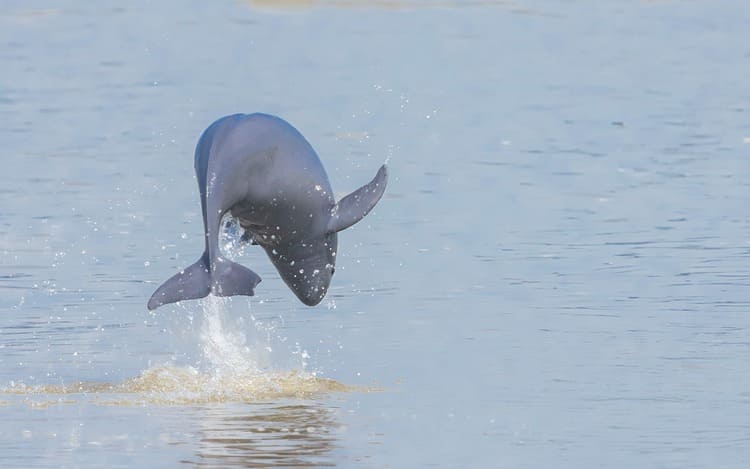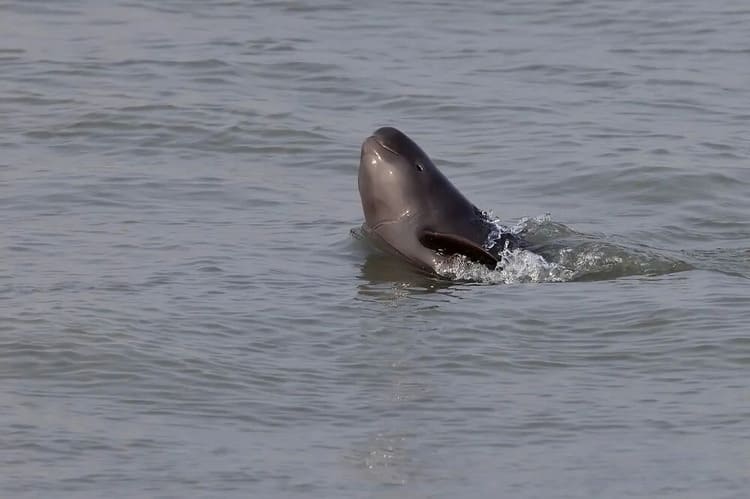Critically endangered: Fewer than 1,000 are thought to remain in the wild, with fragmented sub-populations in the Yangtze River system.
Multiple threats, not just one: Entanglement in fishing gear, vessel strikes, river engineering, shipping noise, water pollution, and habitat fragmentation all compound the decline.
Real conservation momentum: China’s Yangtze River Protection Law (2021) instituted a 10-year fishing ban in key stretches; protected reserves and semi-natural oxbow refuges plus captive-breeding have begun to stabilize some groups.

Common name: Yangtze finless porpoise (also called narrow-ridged finless porpoise)
Scientific name: Neophocaena asiaeorientalis asiaeorientalis (a freshwater subspecies of the narrow-ridged finless porpoise)
Taxon: Order Cetacea (relatives of whales and dolphins)
This is the only porpoise adapted to freshwater anywhere on Earth. Streamlined and small-bodied (up to ~2 m / 6.5 ft and ~100 kg / 220 lb), it lacks a dorsal fin; instead, a narrow, low ridge runs along the back and is studded with tiny tubercles. The head is blunt with no beak, and the species relies heavily on echolocation to hunt in turbid river water.
Core range: Middle–lower Yangtze River in China.
Key strongholds: River sections between Yichang–Jingzhou and Ezhou–Nanjing, plus connected floodplain lakes such as Poyang and Dongting.
Habitat needs: Slow to moderate flow, complex shorelines, seasonal floodplain connectivity, and relatively quiet soundscapes that allow effective echolocation.
Decades of damming, dredging, channelization, and bank hardening have broken the river into ecological fragments, isolating porpoise groups and limiting access to food and breeding areas.
Early 1990s: estimates above 2,500
Mid-2000s: near 1,800
2012 survey of the main stem: ~500 detected
Today: widely reported as <1,000 across river and lake habitats combined
These trends prompted the IUCN Red List to list the Yangtze finless porpoise as Critically Endangered.
This is a classic “death by a thousand cuts” scenario—no single cause explains the downturn; it’s the stacking of threats.
Bycatch & gear conflict
Gillnets and other fishing gear can ensnare porpoises, causing injury, drowning, or chronic entanglement wounds.
Vessel strikes & chronic noise
Heavy shipping traffic raises the risk of collision and introduces underwater noise that masks echolocation clicks and social calls, degrading foraging and navigation.
Pollution
Industrial and agricultural runoff increases turbidity and carries toxins that accumulate in the food web; plastic debris poses entanglement/ingestion risks.
River engineering
Dams, sluices, and dredging simplify habitats, cut off floodplain lakes, and alter seasonal flows crucial for fish and porpoise movement.
Prey depletion
Long-term overfishing reduces forage fish—forcing porpoises to work harder and travel farther for food.

The Yangtze’s other endemic cetacean, the Baiji (Lipotes vexillifer), was declared functionally extinct in 2006 after a last-ditch survey. Its loss underscores the urgency: without aggressive, sustained action, the porpoise could follow the same path.
Yangtze River Protection Law (2021): A landmark 10-year fishing ban in major sections of the river and key tributaries aims to reduce bycatch and allow fish stocks—and by extension porpoises—to recover.
Nature reserves safeguard high-use habitats.
Oxbow sanctuaries (e.g., Tian’e-Zhou) mimic natural conditions with far less boat traffic and fishing pressure. Porpoises translocated here have survived and reproduced, building a safety-net population.
Since the late 1990s, the Institute of Hydrobiology (Chinese Academy of Sciences) has maintained small, carefully managed groups. These support research on acoustics, reproduction, health, and potential reintroduction strategies.
Projects to reopen channels between the main stem and floodplain lakes (e.g., Poyang, Dongting) restore seasonal flows, fish migrations, and movement corridors for porpoises.
Workshops with fishing communities, school programs, and targeted outreach reduce illegal gear use, improve reporting of strandings, and build pride around porpoise stewardship.
Only freshwater porpoise species on the planet
No dorsal fin; narrow ridged back with tubercles
High-frequency echolocation adapted to murky rivers
Indicator species: Its health mirrors the broader river ecosystem’s condition
Support credible NGOs working on Yangtze freshwater conservation, bycatch reduction, and wetland restoration.
Choose sustainable seafood and avoid gear-intensive products tied to gillnet bycatch.
Boost awareness: Share articles, documentaries, or school resources about river cetaceans and the Yangtze’s biodiversity.
Reduce plastic & chemical runoff in your own life—global watersheds are connected.
Why is noise such a big deal for porpoises?
They “see” with sound. Shipping noise can mask echolocation clicks, making it harder to navigate, communicate, and find prey—especially in already turbid water.
What are the top conservation actions right now?
A mix of fishing bans and enforcement, protected river/lake refuges, semi-natural oxbows, captive assurance colonies, and habitat reconnection projects. Education and local co-management are critical to long-term success.
Is recovery realistic?
Yes—if mortality from bycatch and vessel strikes continues to drop, prey recovers, and key habitats remain quiet and connected. Early results from Tian’e-Zhou and other refuges show porpoises can breed and build numbers under the right conditions.
The Yangtze finless porpoise is a singular, freshwater-adapted cetacean teetering on the edge—but not beyond saving. With strong law enforcement, smarter fisheries, quieter river stretches, and reconnected floodplains, this species can persist as the living pulse of Asia’s greatest river.
animal tags: Yangtze finless porpoise
We created this article in conjunction with AI technology, then made sure it was fact-checked and edited by a Animals Top editor.